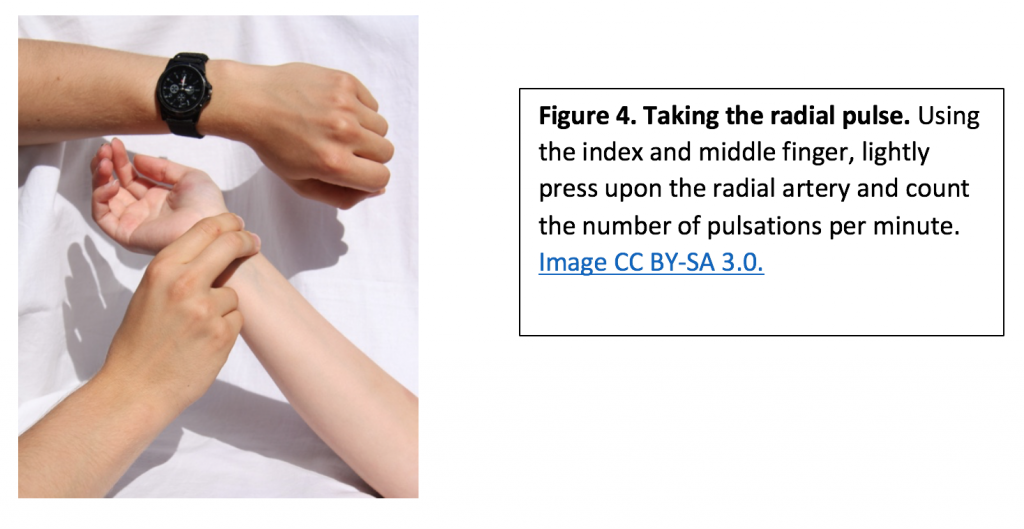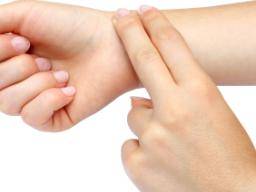Describe the Procedure Used to Take the Pulse
Describe the procedure used to take the pulse. Make sure the patient is relaxed and comfortable.
Health care provider uses a stethoscope or Doppler Ultrasound Stethoscope DUS.

. To check the pulse for instance Radial pulse- Firmly press the first and second finger tips and gently feel the artery in the wrist arearadial and c View the full answer Transcribed image text. If you cannot find the pulse in the wrist feel for it in the neck beside the voicebox or put your ear directly on the chest and listen for the heartbeat. Procedure Ask whether the patient has walked climbed stairs or otherwise exerted themself in the last 20 minutes.
Chapter 33 Problem The_Pulse 31. Place your index first finger and middle fingers on their wrist at the base of their thumb. Data Collected when Assessing the Pulse.
Step 1 Start by asking the patient to take off their shirt. It should always be done with care and reassessed as needed. Directly below the clavicle you should feel the first rib.
You should be able to get 2 fingers snuggly underneath it. The three fingers are used to assess all peripheral sites except the apical pulse. Sit down and rest several minutes before taking your pulse.
Describe the procedure used to take the. When taking your pulse. The space between two ribs is called the.
- For convenience and ease it is best to record the radial pulse. Using the first and second fingertips press firmly but gently on the arteries until you feel a pulse. Using a clock or watch that counts seconds count how many beats you feel in a minute or count them over 30 seconds and multiply the number by 2.
If the patient has taken any medication - this may alter the pulse rate. With your palm up look at the area between your wrist bone and the tendon on the thumb side of your wrist. Push straight down on compress the chest at least 2 inches 5 centimeters but no more than 24 inches 6 centimeters.
You may have to move your fingers along the bone or slightly to either side to feel the pulse. Your radial pulse can. Palpate brachial pulse and place the blood pressure cuff 1-2 inches above where you found the pulse.
Once you have found your pulse count the beats for 15 seconds. Use your entire body weight not just your arms when doing compressions. Have the patient to lie down or sit up to have the pulse taken.
Take your pulse the same time each day. Next apply a light pressure to the area until you can feel the pulsating. Chapter 33 Problem The_Pulse 31.
The clavicle is also called the collarbone. To take the pulse put your fingers on the wrist as shown do not use your thumb. It can be felt at the top of the rib cage.
We also outline the health. Push hard at a rate of 100 to 120 compressions a minute. Assessing the pulse is a common procedure and an important aspect of many nursing interventions.
Nurses should have a watch that has a second hand to. First of all put your index finger and your middle finger the largest fingers next to each other together on the side of your wrist with your palm. Your healthcare team may include a cardiologist a technician a nurse and an anesthesia provider.
In this article we describe the procedure for measuring the apical pulse. To take the apical pulse you will need to access the bare chestStep 2 Feel the first rib by finding the clavicle. - Count the pulse for a full minute in order to detect any arrhythmias abnormal rhythms.
DUS is used for pulses that are difficult to assess. Financial Institutions Instruments and Markets 8th Edition. Place the tips of your first and second finger on the inside of the patients wrist.
Compress firmly and then release. How to Take a Pulse. To measure the pulse in someones wrist.
- Place your first and second finger along the artery - apply light pressure until you feel the pulse. Feel for the clavicle. Taking your radial pulse.
Place the buds of the stethoscope in the ears and place the disk portion over the patients heart. A stethoscope is placed over the patients heart to get a pulse. Normally you will do this with your wrist facing upwards.
Hold the persons arm so its straight with the palm of their hand facing upwards. Methods Used in Assessing the Pulse. Wrap cuff around the upper arm so it fits appropriately.
Cardiac ablations take place in a special room known as an electrophysiology laboratory. However a doctor cannot make an official diagnosis based on a persons apical pulse alone. Begin counting the pulse when the clocks second hand is on the 12.
Then palpate the brachial pulse with your non-dominate hand and inflate the cuff using the rubber bulb with your dominate hand. At the wrist in front of the ear on the dorsum of the foot at the side of the neck 103 When Human Cardiovascular Physiology Blood Pressure and Pulse Determinations Palpating the various. Count your pulse for a full 60 seconds unless told otherwise by your health care provider.
Count your pulse for 60 seconds or for 15 seconds and then multiply by. Assessment should always be taken seriously with any deviations from the norm reported to a senior clinician and pulse rate rhythm and strength must always be documented. Describe the procedure used to take the pulse.
Place the first 2-3 fingertips of one hand over an arterial pressure point.

Clinical Techniques Assessment Of Vital Signs A Mixed Course Based Research Approach To Human Physiology

Hesi Case Studies Cardiac Nursing Medical Transcription Cardiac Catheterization

Cardiac Catheterization Cardiac Catheterization Cardiac Nursing Cardiac


Comments
Post a Comment